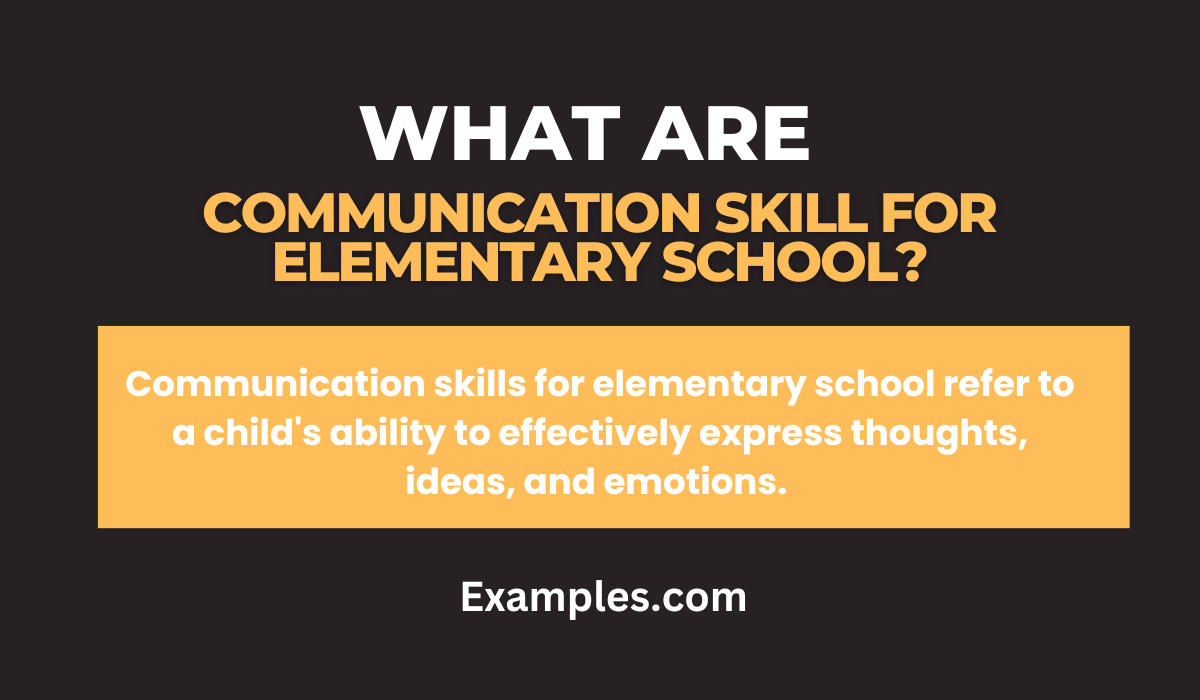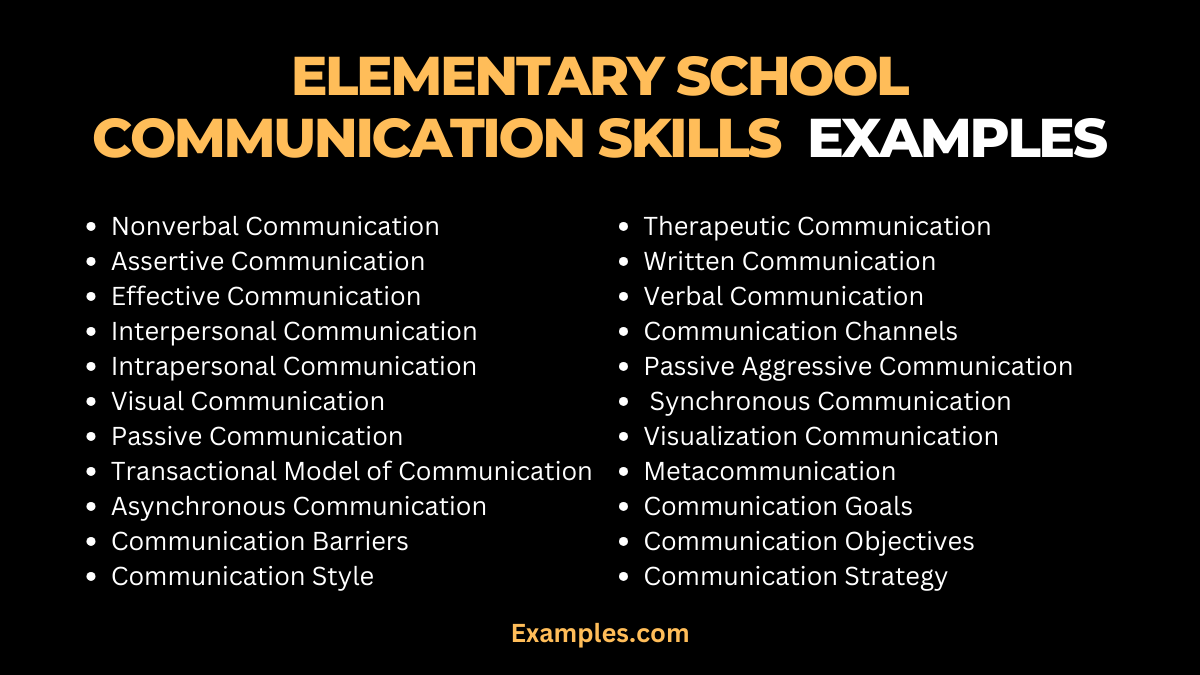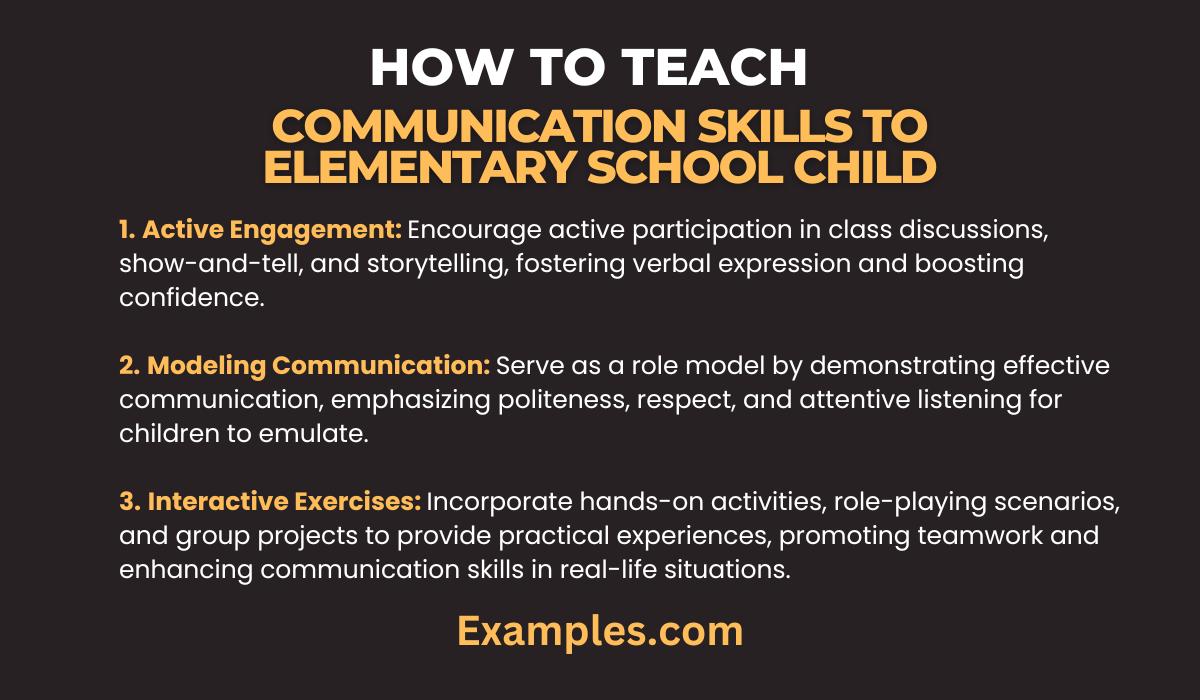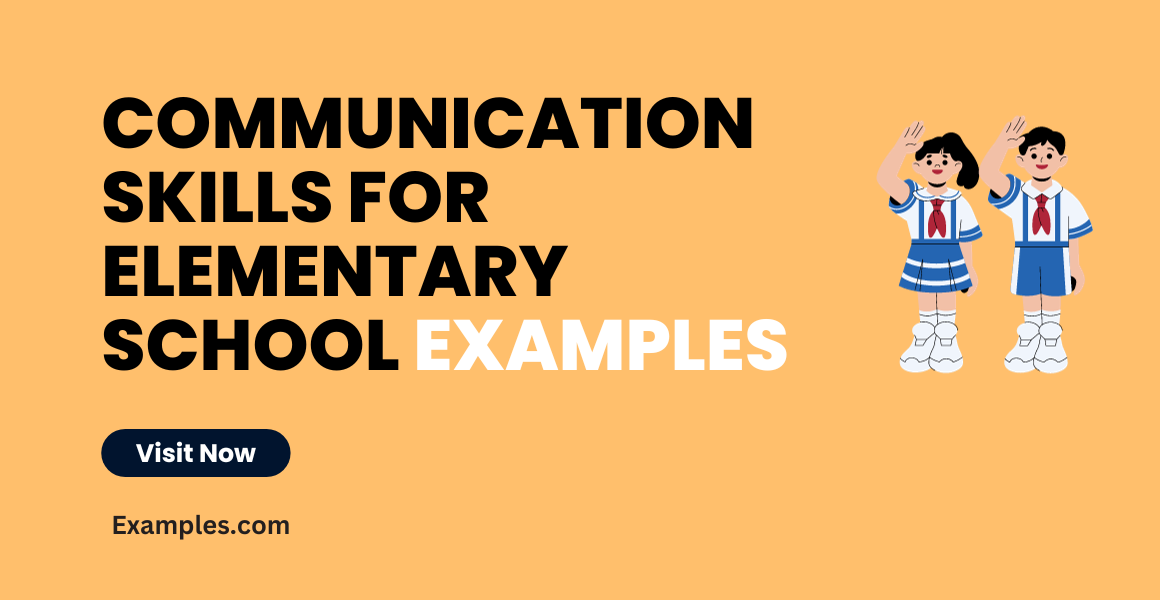29+ Communication Skills for Elementary School Examples
Unlock the secrets of fostering effective communication skills in elementary school children with our comprehensive guide. Dive into a world of interactive learning, empowering both students and educators. From practical examples to valuable insights, this guide is designed to enhance communication abilities, creating confident and articulate young learners.
What are Communication Skills for Elementary School?
Communication skills for elementary school encompass the ability to express thoughts, ideas, and emotions effectively. In simple terms, it involves verbal and nonverbal communication, fostering connections between students, teachers, and peers. These skills lay the foundation for successful academic and social development, shaping the way children interact with the world around them.

30 Communication Skills for Elementary School Example

Nurturing effective communication skills in elementary school is foundational for a child’s growth. Through interactive activities, students develop oral communication by actively participating in discussions. Encouraging descriptive expression builds nonverbal communication, fostering emotional intelligence. Introduction of age-appropriate communication technology facilitates virtual collaboration. Settling into communication goals, like asking questions in class, instills confidence. This comprehensive approach prepares elementary students for academic success and social adeptness, creating a solid foundation for their future communication endeavors.
- Nonverbal Communication: Using facial expressions and gestures to convey emotions.
Example: In a game of charades, children express feelings without speaking. - Assertive Communication: Teaching kids to express opinions confidently but respectfully.
Example: A child saying, “I prefer playing this game today,” assertively. - Effective Communication: Cultivating clarity and coherence in verbal and written expression.
Example: Clearly explaining a drawing during show-and-tell. - Interpersonal Communication: Encouraging teamwork and positive interactions.
Example: Working collaboratively on a group project, sharing ideas. - Intrapersonal Communication: Helping children understand and manage their own emotions.
Example: Reflecting on personal feelings through journaling. - Visual Communication: Using drawings, charts, and diagrams to enhance understanding.
Example: Creating a visual poster to explain a science concept. - Passive Communication: Promoting active listening without interrupting.
Example: Listening attentively during storytime without speaking. - Transactional Model of Communication: Illustrating the exchange of messages between sender and receiver.
Example: Engaging in a back-and-forth conversation about a favorite book. - Asynchronous Communication: Understanding communication that doesn’t happen in real-time.
Example: Sending a letter to a pen pal and waiting for a response. - Communication Barriers: Identifying obstacles and finding ways to overcome them.
Example: Using gestures when language barriers exist between peers. - Communication Style: Embracing different ways of expressing thoughts and ideas.
Example: Choosing between drawing or writing to share a personal story. - Therapeutic Communication: Developing empathy and active listening skills.
Example: Comforting a friend who is upset with supportive words. - Written Communication: Expressing ideas through written words and sentences.
Example: Composing a thank-you note for a thoughtful gesture. - Verbal Communication: Mastering the art of expressing thoughts and ideas verbally.
Example: Clearly articulating preferences during group decision-making. - Communication Channels: Understanding various mediums for conveying messages.
Example: Choosing to share news with classmates through a class announcement. - Passive Aggressive Communication: Recognizing indirect expression of negative feelings.
Example: Making sarcastic comments about a decision instead of directly addressing concerns. - Synchronous Communication: Engaging in real-time conversations.
Example: Participating in a live online class discussion. - Visualization Communication: Using mental imagery to enhance understanding.
Example: Visualizing a story while listening to it during read-aloud time. - Metacommunication: Understanding and discussing the communication process.
Example: Talking about how a miscommunication occurred and finding a solution. - Communication Goals: Setting objectives for improvement in communication skills.
Example: Striving to ask questions during class discussions to enhance participation. - Communication Objectives: Defining specific targets for enhancing communication abilities.
Example: Setting a goal to improve pronunciation by practicing with peers. - Communication Strategy: Developing a plan for effective communication in different situations.
Example: Planning how to express thoughts before a show-and-tell presentation. - Indirect Communication: Expressing thoughts subtly without direct statements.
Example: Using body language to show excitement without saying a word. - Linear Model of Communication: Understanding the step-by-step process of sending and receiving messages.
Example: Discussing how a message changes as it passes from speaker to listener. - Downward Communication: Learning to receive and understand instructions from authority figures.
Example: Following teacher instructions for a class activity. - Ineffective Communication: Identifying communication that doesn’t achieve its intended purpose.
Example: Misunderstandings arising from unclear instructions during a game. - Nonviolent Communication: Resolving conflicts peacefully through effective communication.
Example: Discussing feelings and finding a compromise during a disagreement. - Professional Communication: Introducing formal language and behavior appropriate for specific situations.
Example: Practicing polite greetings during a school event. - Conflict Resolution Communication: Resolving disputes through open communication and understanding.
Example: Talking through a disagreement with a friend and finding a solution. - Empathetic Communication: Developing the ability to understand and share the feelings of others.
Example: Offering support and kind words to a classmate facing challenges.
Communication Skills for Elementary School Students Examples at Work
Elementary students, equipped with fundamental communication skills, can excel not only in the classroom but also in simulated work environments. Fostering assertive communication, students confidently express ideas during group projects. Introducing simple transactional communication scenarios enhances teamwork. Early exposure to workplace-like scenarios cultivates a sense of professionalism, setting the stage for future success.
- Effective Communication: Presenting a collaborative project with clarity during a pretend “office meeting.”
- Communication Styles: Exploring different ways of expressing ideas through drawings, enhancing visual communication.
- Mediated Communication: Using a designated “office chat” to discuss project details with classmates.
- Communication Objectives: Setting goals for efficient communication within a group activity.
- Functional Communication Training ABA: Incorporating structured communication exercises to reinforce essential skills.
- Digital Communication: Simulating email exchanges for sharing ideas and collaborating virtually.
- Business Communication: Role-playing as team members in a simulated business scenario, practicing professional interactions.
- External Communication: Collaborating with another “team” to exchange information and resources.
- Competency Communication: Showcasing individual strengths during a pretend job fair.
- Lateral Communication: Facilitating teamwork by encouraging lateral communication among peers.
Communication Skills for Elementary School Student Examples for Study
Effective communication skills are not only essential for the future workplace but also integral to academic success. Encouraging therapeutic communication, students learn to support classmates emotionally during study sessions. Implementing near field communication in group study fosters close collaboration. These examples instill study habits and interpersonal skills that are beneficial throughout the academic journey.
- Ineffective Communication: Demonstrating the consequences of poor communication in a study scenario.
- Cross Cultural Communication: Discussing diverse study approaches, respecting various cultural perspectives.
- Communication Process: Mapping out the steps of collaborative studying to understand the communication flow.
- Storytelling in Communication: Narrating study concepts creatively to make them more memorable.
- Indirect Communication: Using visual cues and gestures to convey study-related ideas.
- Linear Model of Communication: Illustrating the sequential nature of effective study group interactions.
- Environmental Communication: Creating a conducive study environment through clear communication about expectations.
- Self Evaluation Communication: Encouraging students to reflect on their contribution to group study sessions.
- Feedback in Communication: Offering constructive feedback on study strategies to enhance collective learning.
- Interaction Model of Communication: Emphasizing the dynamic exchange of ideas during collaborative study efforts.
What are Communication Skills for Elementary School Students?
Communication skills for elementary school students encompass a range of abilities crucial for their academic and social growth. Here are ten key communication skills that contribute to a well-rounded education:
- Verbal Proficiency: The ability to express thoughts and ideas clearly through spoken words.
- Active Listening: Engaging attentively in conversations and processing information to comprehend others’ perspectives.
- Nonverbal Communication: Understanding and utilizing nonverbal cues, including body language and facial expressions.
- Expressing Emotions: Effectively communicating and managing one’s emotions, promoting emotional intelligence.
- Respectful Communication: Interacting with peers, teachers, and adults using polite and respectful language.
- Team Collaboration: Engaging in group activities, demonstrating teamwork, and effectively contributing to shared goals.
- Empathy: Understanding and acknowledging the feelings of others, fostering a compassionate and inclusive environment.
- Conflict Resolution: Developing skills to resolve conflicts peacefully and communicate needs and concerns assertively.
- Presentation Skills: Gaining confidence in presenting ideas, whether through show-and-tell or classroom projects.
- Digital Communication: Learning responsible and appropriate communication in the digital age, including online discussions and collaboration.
What are Essential Communication Skills for Elementary School?
In the dynamic realm of elementary education, essential communication skills are pivotal for holistic development. These skills include:
- Verbal Communication: The ability to express thoughts and ideas coherently through spoken words.
- Nonverbal Communication: Understanding and using gestures, body language, and facial expressions effectively.
- Active Listening: Developing the capacity to attentively listen and comprehend information during discussions.
- Interpersonal Skills: Nurturing positive interactions with peers, teachers, and other members of the school community.
- Conflict Resolution: Teaching students to resolve disagreements amicably and understand diverse perspectives.
- Public Speaking: Fostering confidence in expressing ideas in front of an audience, promoting self-assurance.
- Writing Skills: Developing the ability to convey thoughts clearly and cohesively through written expression.
- Empathy: Cultivating an understanding of others’ feelings and perspectives, fostering a supportive environment.
- Collaboration: Encouraging teamwork and cooperation, essential for group projects and activities.
- Digital Communication: Introducing age-appropriate digital communication skills for modern educational environments.
These fundamental communication skills lay the groundwork for academic success and positive social interactions.
How do you Teach Child Communication Skills for Elementary School?
Fostering effective communication skills in elementary school children is a rewarding endeavor that lays the groundwork for academic success and social growth. Here are ten points to guide educators and parents in teaching communication skills to young learners:

- Encourage Active Listening: Teach children the importance of attentive listening, emphasizing the value of understanding others’ perspectives before expressing their own.
- Promote Verbal Expression: Provide opportunities for students to express themselves verbally, whether through show-and-tell activities, class discussions, or storytelling sessions.
- Integrate Nonverbal Communication: Help children recognize and utilize nonverbal cues such as body language and facial expressions to convey emotions and messages effectively.
- Cultivate Empathy: Foster an environment that encourages empathy by discussing feelings and emotions. This enhances children’s ability to connect with their peers and understand different points of view.
- Role-Playing Exercises: Engage students in role-playing scenarios to practice effective communication. This hands-on approach helps build confidence and reinforces key communication skills.
- Teach Politeness and Respect: Emphasize the importance of polite language and respectful communication. Encourage phrases like “please” and “thank you” to instill courteous habits.
- Provide Constructive Feedback: Offer constructive feedback on students’ communication efforts. Highlight strengths and suggest areas for improvement, fostering a growth mindset.
- Group Activities: Incorporate group activities that require collaboration and communication. This helps children learn how to express their ideas within a team setting.
- Utilize Technology Thoughtfully: Integrate age-appropriate technology to enhance communication skills. Educational apps, video projects, and online discussions can provide valuable learning experiences.
- Model Effective Communication: Act as a role model by demonstrating effective communication in the classroom or home. Children often learn by observing, making positive examples essential for their development.
What are the Ways to Improve Communication Skills for Elementary Schools?
Enhancing communication skills in elementary schools involves adopting targeted strategies:
- Engaging Activities: Incorporate interactive activities, such as role-playing and group discussions, to make learning communication skills enjoyable.
- Storytelling Sessions: Encourage storytelling to develop narrative and verbal expression skills, enhancing creativity.
- Visual Aids: Utilize visual aids like charts, pictures, and videos to enhance understanding of nonverbal communication cues.
- Peer-to-Peer Interaction: Facilitate peer interactions to promote the application of communication skills in various social contexts.
- Classroom Games: Introduce educational games that focus on communication, making the learning process dynamic and entertaining.
- Regular Feedback: Provide constructive feedback to students, emphasizing areas for improvement and acknowledging their successes.
- Inclusive Activities: Foster an inclusive environment where all students feel comfortable expressing themselves without judgment.
- Real-life Scenarios: Integrate real-life scenarios into lessons to connect theoretical knowledge with practical communication applications.
- Technology Integration: Introduce age-appropriate technology tools for communication practice, aligning with modern educational trends.
- Parental Involvement: Engage parents in reinforcing communication skills at home, creating a collaborative approach to learning.
Tips for Effective Communication Skills for Elementary Schools
Empower educators and parents with actionable tips to nurture effective communication skills:
- Model Communication: Demonstrate effective communication through clear articulation, active listening, and respectful interaction.
- Encourage Questions: Create an environment where students feel comfortable asking questions, fostering curiosity and clarity.
- Storytime Rituals: Establish regular storytime rituals, allowing children to express themselves through storytelling.
- Positive Reinforcement: Acknowledge and reinforce positive communication behaviors to motivate continued improvement.
- Interactive Learning Tools: Integrate interactive learning tools that cater to different communication styles and preferences.
- Cultural Sensitivity: Promote cultural sensitivity, teaching students to communicate respectfully in diverse settings.
- Conflict Resolution Workshops: Conduct workshops on conflict resolution, equipping students with essential skills for resolving disputes.
- Celebration of Diversity: Embrace and celebrate diversity, encouraging students to appreciate different communication styles.
- Collaborative Projects: Assign collaborative projects to foster teamwork and communication skills within a group setting.
- Continuous Learning: Recognize that communication skills are continuously evolving, and encourage a lifelong commitment to improvement.
In conclusion, the guide to communication skills for elementary school delivers a roadmap for cultivating essential abilities in young learners. From active listening to verbal expression, these skills lay the foundation for academic success and positive social interactions. Empowering students with effective communication enhance their educational journey, fostering confident and articulate individuals ready to navigate the complexities of the world.



